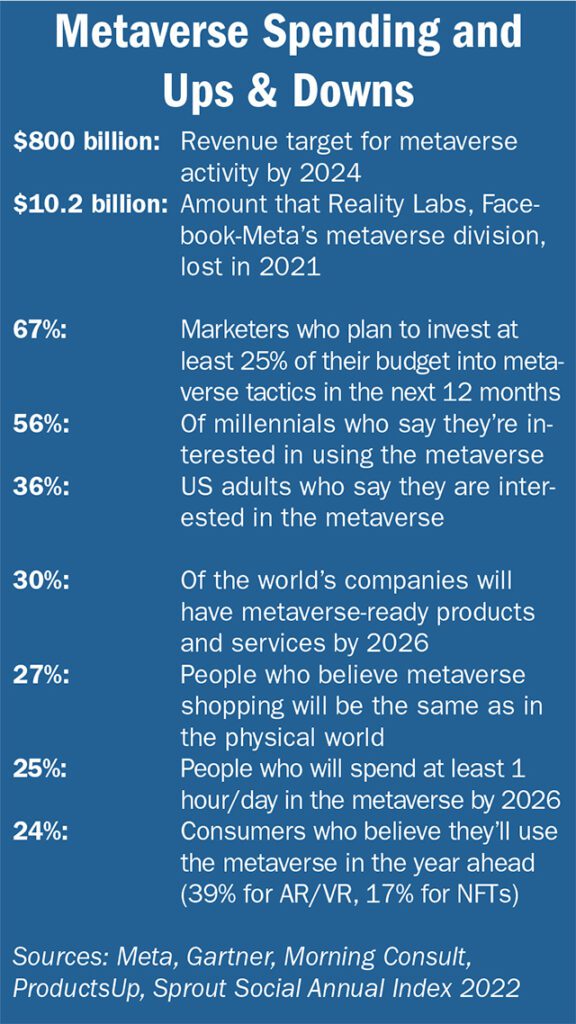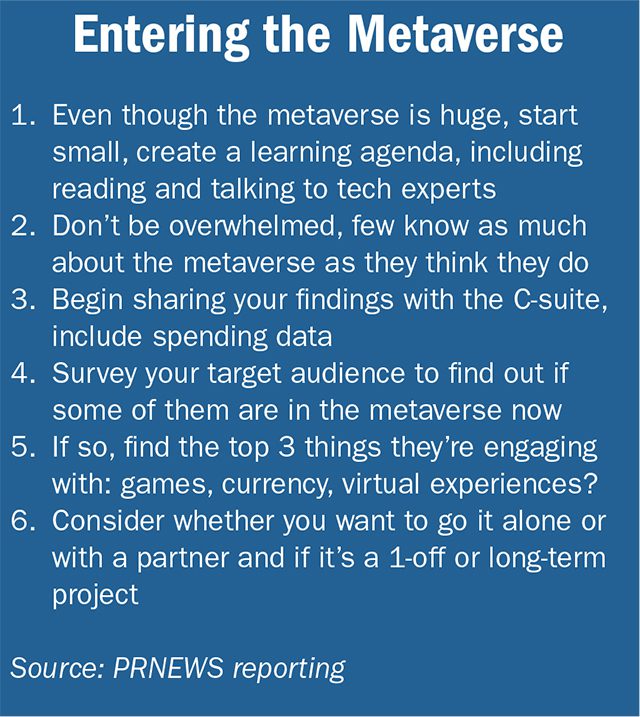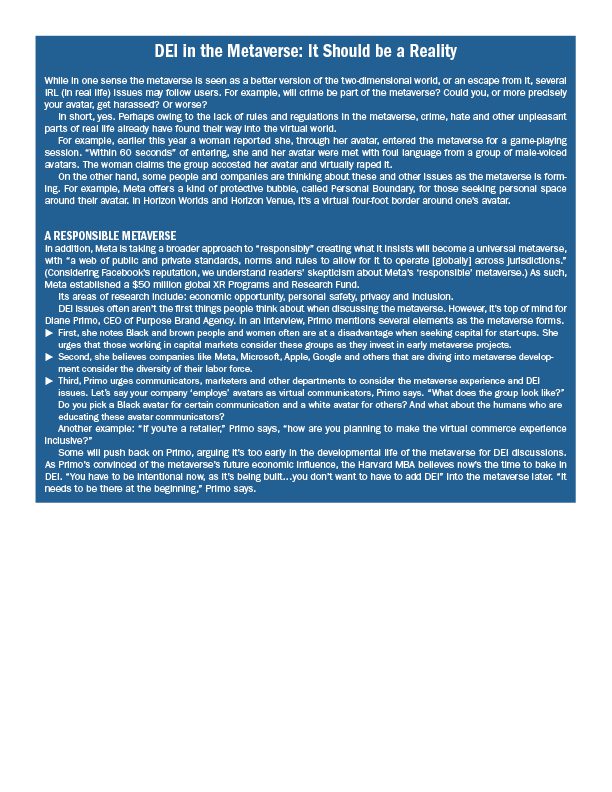
We received an email with this subject line: “Marketing EXPERT Says The Time is NOW to Invest in METAVERSE Marketing” (capitalizations are the writer’s).
“The metaverse will absolutely be the next frontier for advertising and e-commerce (our emphases throughout). The question is not if, but when people will adopt it. Larger companies should invest in creating virtual experiences in the metaverse today, so that they can be first to market when the technology is more widely adopted.”
The email is typical of the absolutism and hubbub associated with the metaverse. But this email writer is not alone. For example, Gartner believes “the metaverse will impact every business that consumers interact with every day.” Spending on VR and AR, two of the metaverse's major technologies, is estimated to jump from $12 billion in 2020 to $72.8 billion in 2024.
Metaverse versus Meta
True, Mark Zuckerberg is bullish on the metaverse, has renamed Facebook Meta and claims it’s now “a metaverse company.”
On the other hand, Zuckerberg also said recently it will be at least 15 years before the metaverse is fully realized. At the moment, Reality Labs, Meta’s metaverse-building unit, is bleeding billions of dollars (see table).
Accordingly, the latest plans call for a slowing of Meta’s metaverse activities in favor of concentrating on immediate issues. A 40 percent decline in your share price since 2022’s start can make you think of today rather than 15 years ahead. More than that, early adopters seem excited about the metaverse, but few others are, surveys show.
Of course, Meta’s not alone in slowing its metaverse thrust. The tech sector has taken a bath so far in 2022. And considering the tightening capital markets and a possible recession, the likelihood companies will grow their metaverse investments significantly seems iffy, says Kevin Martin, a director at Bospar. “When capital gets tight, obviously, the metaverse and NFT's and other futuristic ideas are… going on the back burner…because it is well down the road.”
Ponzi Scheme?
Similarly, Martin acknowledges there are many critics who consider the metaverse, particularly the crypto portion of it, “a huge rug-pull or Ponzi scheme.”
On the other hand, serial entrepreneur and marketer Eric Dahan, CEO, Open Influence, sees the commerce portion of the metaverse as a near certainty. “Once there's enough adoption” of VR, which will emanate from gamers, “the commerce [portion of the metaverse] is going to sort of flow.”
With some exceptions, like users outfitting their avatars with expensive status symbols–we’ve already seen a digital Gucci handbag sell for $4,000, more than the physical bag–he believes the metaverse commerce experience will resemble online shopping. He concedes, “there’s a lot we need to figure out” before virtual shopping gets big. For example, will we all shop in an Amazon virtual space or will it be tailored to you alone? Will every piece of clothing have a virtual model or just some of them?
But it’s almost immaterial whether or not the metaverse eventually succeeds. As strategists, it behooves communicators to become familiar with it regardless.
For PRNEWS readers who already are communicating in the metaverse, the article should confirm your activities.
Looking Ahead
Yet its main target are PR pros awash in daily communication issues and who’ve seen words like metaverse, Web3, NFT, blockchain and crypto, Roblox and Nvidia, but haven’t explored them deeply.
Inevitably the day will come when one’s boss–perhaps resulting from her supervisor’s prompting–will approach you and ask a variation on: What’s the Communication team doing about the metaverse? Do we have any content out there yet? If not, when will we? My kid’s always talking about Decentraland. Shouldn’t we be there?
Getting you ready for these questions is this article’s purpose.
First, take a breath. There’s little agreement on what the metaverse is or even a definition of it. Yet, in simple terms the metaverse is a parallel venue to the physical world. Using avatars, you can exist in this world digitally. Already, people have played video games (the biggest draw so far), attended conferences and entertainment events, such as concerts, taken tours, shopped in virtual malls and gathered to socialize.
[Note: Readers can familiarize themselves with metaverse terms and AP style here and crypto terms here. In addition, there’s an excellent primer on metaverse legal issues here.]
Dahan sees the metaverse as an “alternative to physical interaction” and “a 3D-model extension of the internet.” It’s the internet’s “next step,” he adds. But instead of interacting on web pages, people “interact in a virtual space similar, to a video game.”
AR and VR
Similarly, Diane Primo, CEO, The Purpose Brand, sees the metaverse as “a simulated digital environment that uses augmented reality (AR), virtual reality (VR) and blockchain, along with concepts from social media, to create spaces for rich user interaction mimicking the real world.”
Take another breath. It’s possible you’ve experienced the metaverse without knowing it, maybe during a pandemic lockdown.
Did you see the episode of “The Simpsons” where Marge Simpson wore a Balenciaga dress? That’s also considered an example of the metaverse, in that, as Dahan and Primo say, it’s an alternative to the physical world. In this case, Ms. Simpson is a virtual influencer.
And do you recall this scene in the film “Disclosure” (1994), when Michael Douglas’s character dons special gloves and glasses to enter the virtual-reality corridor? See, you’ve known about the metaverse for years.
Hopefully, at this point your anxiety is declining and your confidence is rising. Here are a few more things that should help.
Thinking about the communication implications, consider the metaverse simply as an additional social platform, another tool through which PR pros and marketers can interact with audiences.
New Communication
Along these lines, Primo mentions Mary Spio, founder of Ceek, a content developer who works in the AR and VR spaces. Citing Spio, Primo says, the metaverse “will enable content creators to connect with audiences in a whole new way.”
For example, you can join friends and step into a movie, feel the rush of your favorite team running by you, spend time up close with your favorite sporting events.
And you’ve learned many lessons about the metaverse through your work with social media.
For example, some parts of the metaverse may be a fit for your business, but won’t work well for another PR pro’s company, says Michael Lamp, chief digital ad social officer at HUNTER.
In this way, the metaverse, he says, is similar to other social platforms. “Remember how businesses were clamoring to get on TikTok? In the end, it was great for a lot of them and didn’t work for others,” Lamp says.
Moreover, a metaverse element that works today for a business and its target audience may not tomorrow, Lamp says. His example is Facebook, which began life, in 2004 in Zuckerberg’s dorm room, as the new cool thing for a young demo. It’s now associated with an older audience.
Of course, as they mature, all platforms seemingly attract older users. This includes TikTok and even the metaverse.
'Everyone Knows That.' Not
In addition, here’s a big anxiety-reducer. Understand that “nobody really knows as much about the metaverse as they think they do,” says Lamp, who’s tech-savvy. He concedes a lot of people are googling terms on their phones during conferences, either underneath the table or out of Zoom-camera range. “The good news is everyone should take relief [since]…we’re still learning this thing,” he adds.
Here’s something that raises concern. In spite of being in its formative stages, the metaverse has generated a huge amount of hype. In fact, while it’s a small sampling, everyone we spoke with for this article uttered the word hype.
One of the best things PR pros can do is ignore the metaverse hype, or try. “It’s as if the metaverse has gone from 0 to 60 overnight…from mentions in think pieces in 2020 to the word du jour last year to everybody’s new marketing play” now, says Lamp.
Those sentiments put a serious crimp in the email message mentioned at the start of this article, ie that you must invest “now” in metaverse marketing and communication.
Controlled Aggressiveness
On the other hand, you probably shouldn’t sit idle either. Adopt a stance of controlled aggressiveness, those we interview say. Begin exploring the metaverse sooner rather than later.
After all, part of the communicator’s remit is thinking ahead. So, planning now for how and where you will communicate is prudent. With predictions of significant spending associated with the metaverse [see chart], it’s time for PR pros to begin their homework.
Learn the terms, look at the technology, decide how, where, when and if your company and its communication may enter the metaverse.
“Take the time to understand and filter the possibilities from the propaganda,” is how Jared Carneson, FleishmanHillard senior partner and emerging platforms lead, puts it.
Investigating now is not too much to ask, Lamp believes. “Even if you don't feel like it makes sense for your business, or if your audience isn't really there yet…this is catching on fast and reaching people more quickly than we've ever seen before.” So, it’s sensible to take a look, Lamp says.
“Widen your ability to problem-solve with an all-encompassing view of emerging media,” is how Carneson puts it. Indeed, this anti-hype, investigative approach is powering FleishmanHillard’s just-announced learning lab that Carneson will oversee.
The company, he says, doesn’t want to “usher in metaversal or web 3 experiences.” Instead, it wants to “help clients harness emerging technology as part of a solution where it can truly bring business value and utility.”
Tech Knowledge
In addition to having a basic of understanding of the technology behind the metaverse, Martin and his colleague Curtis Sparrer, Bospar’s co-founder, believe communicators should understand “what others are thinking” and writing, Martin says. “Understand who's covering the space [among journalists and influencers]. Who has opinions on what it's going to be, what it can be or what it might look like and how it might change.”
“Understand the offering” and the rules such as they are, Sparrer adds. “And get the best people in the room” to learn about the metaverse’s potential and “how things are going to fluctuate in any market situation, because that's what happens with new technology.”
“Understanding what sort of beachhead [your company is planning for the metaverse] is the most important step a communicator can take. It will determine the sort of strategies and tactics that you're going to roll out to make your efforts work.”
Sparrer adds communicators should avoid thinking the downturn in metaverse spending means they can slow their exploration. “We will have peaks and valleys,” he says, “that has to be part of your plan.”
For small communication shops, Primo recommends hiring top-notch summer interns and tasking them with ideation for metaverse communication ideas. At this stage, she says, just have them come up with ideas, “don’t worry about operations” or resources. Eventually, she says, have them explore these ideas with executives, who will look at them with cost and operations background.
Goals and Audience
Once you’ve looked at some of the basics, it’s imperative to consider another PR maxim: goals and audience research. “Don’t look to execute a metaverse [play just] for the sake of execution,” Carneson says.
Instead, consider what your business might want to accomplish using metaverse tools and technology. Are you representing a legacy business or one whose target audience is young? Is your audience residing in the metaverse today? Will it do so next month, next year, in five years?
For some companies it’s a guns-and-butter question, Sparrer says. “If I invest this much of my [communication budget] in the metaverse, how much is left” to spend on existing assets?
Several questions for consideration along these lines:
- Do you want to sell an experience, a place where people can go via their avatar?
- Do you want a billboard with your company’s name on it to exist in metaverse venue? Perhaps a venue like Roblox could include a mention of your company or its products?
- Are you accepting payments via crypto?
- Are you issuing NFTs, perhaps as part of a product launch?
- Will your metaverse project be a one-off or a long-term commitment?
- Do you intend to work with a partner in the metaverse or go it alone?
- When do you want to do these things?
- And how will you measure success?
Within these questions is a wide swath. “Saying you want people [living in the metaverse] to be aware of you and your brand. To care about you…that’s a huge question,” Lamp says. “What do you really mean? Do you want them to be interested in you or actually convert?”
The next question is “who are you looking to reach?” Answering that question will influence your route into the metaverse. “Taking the metaverse out of it for a moment, social and digital success really comes down to being on the right channels with the right methods and message.”
Similarly, Dahan says “if you're trying to do everything, you're going to do nothing.”
Easy Does It
Adds Martin, don’t force your audience into the metaverse. Instead, it should be an “authentic” play and communicated authentically, he says. As such, he recommends audience-testing metaverse initiatives before investing in them.
Says Sparrer, "start slowly" and see through testing “what moves the needle.” Consider, Martin says, if something in the metaverse is “authentic to your brand at this point in time…that’s critical for any company,” whether or not it’s a metaverse push, he adds.
Similarly, Dahan says, “first and foremost is figuring out what's key for you, figuring out what's going to drive the most impact, and then asking yourself the honest question of whether or not you can leverage the metaverse or Web3 to drive that.”
Just as in the physical world there are myriad stores and products, the metaverse too is “this vast thing…not all these ‘stores’ will matter to your audience,” Lamp says. “It's up to you, as the marketer, to find the places or the pockets that matter and then determine the best way to reach them.”
On the other hand, Lamp concedes the ways you reach people in the metaverse is “more experiential” than on a typical social media platform.
Experiences
As such, let’s look at communicating in the metaverse. Let’s assume you’re introducing a product in the real world, say a healthy sandwich, “popping it up virtually, to expose the audience to its existence can be interesting,” Lamp says.
Even better, perhaps you could make it part of a game experience for gamers. If your avatar consumes the sandwich, you pick up points in the game. “So, now you’ve introduced this healthy product in a stronger way, so [the gamer] understands [the product has health benefits and] why the product matters in both the virtual and real world…we can actually change the way someone experiences life virtually for the better…it’s a much stronger message than a standard Instagram post.”
Expanding the scenario, let’s say the sandwich is sold at a national chain. “We know our audience is in the metaverse, because we introduced the sandwich in a gaming environment. Let’s create a pop-up food truck in Roblox, or another meta environment.” So, when people log in to Roblox they walk right past your food truck and say, ‘What's this? It wasn't here yesterday.’
After that, perhaps there’s a promotion. The person, through her avator, does something in the metaverse, gets the sandwich and also receives an offer to pick up two sandwiches in the real world, perhaps using a virtual currency that can be redeemed in real life. “That’s a pretty classic PR tactic,” Lamp says.

